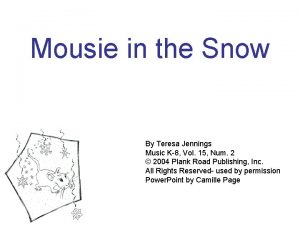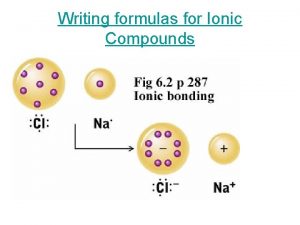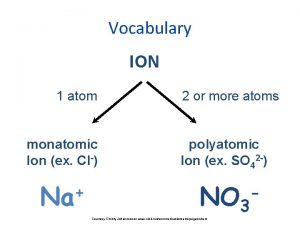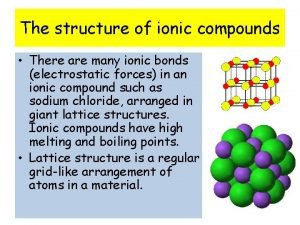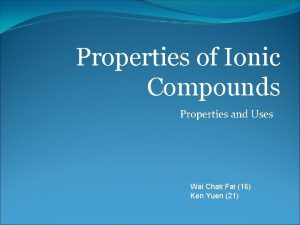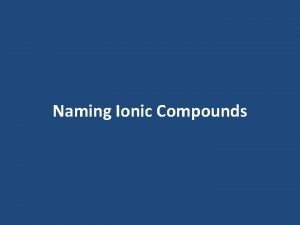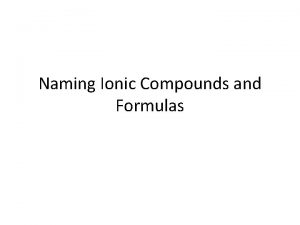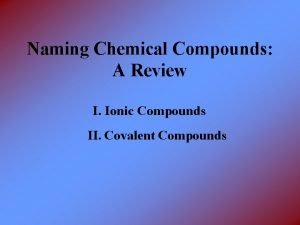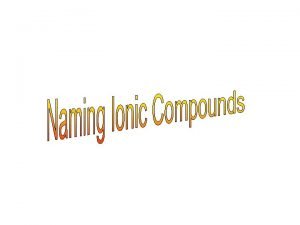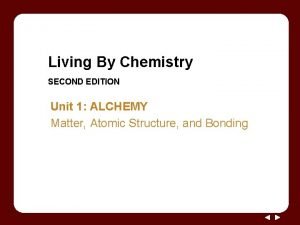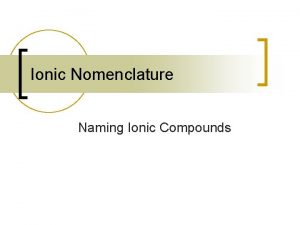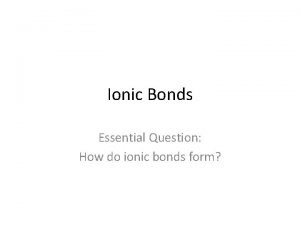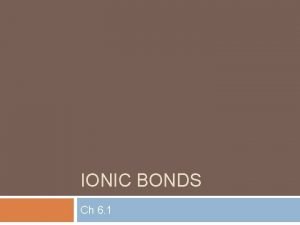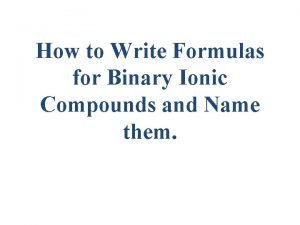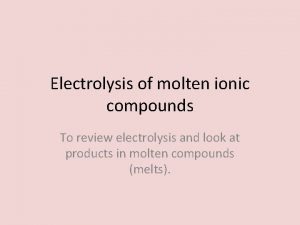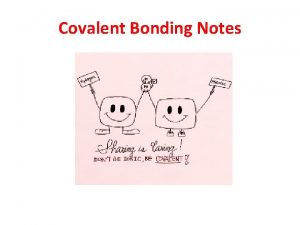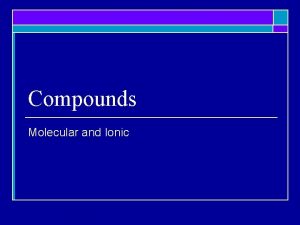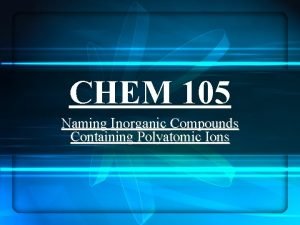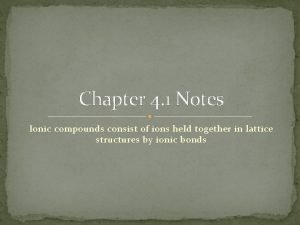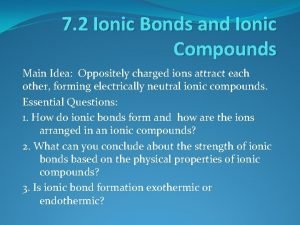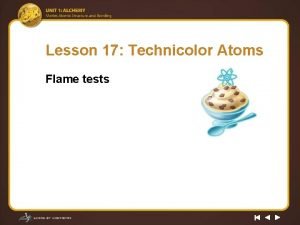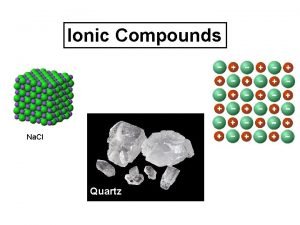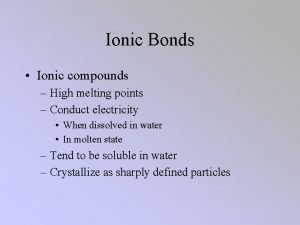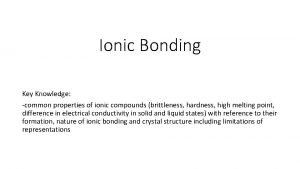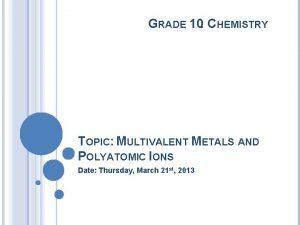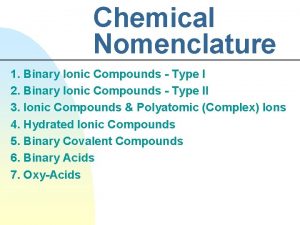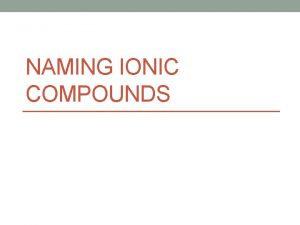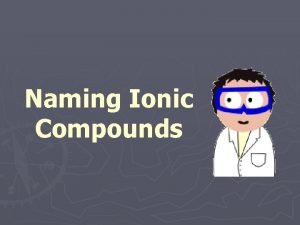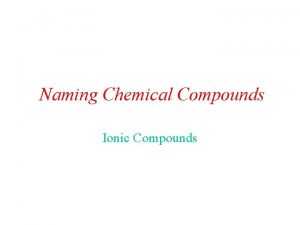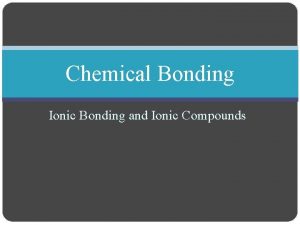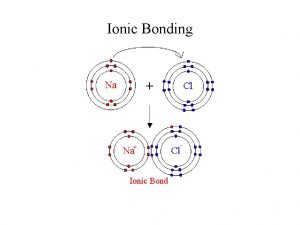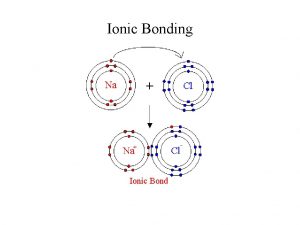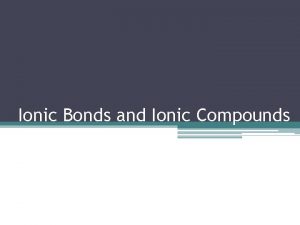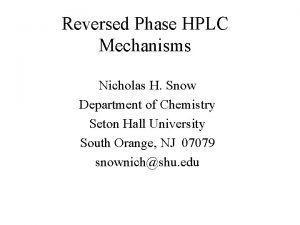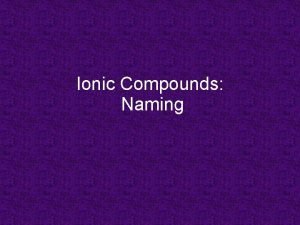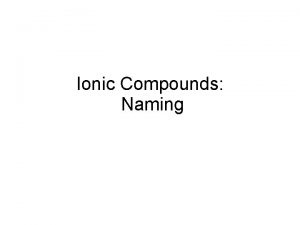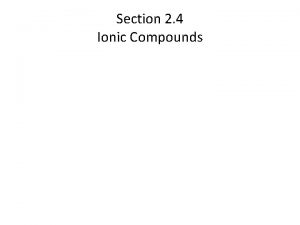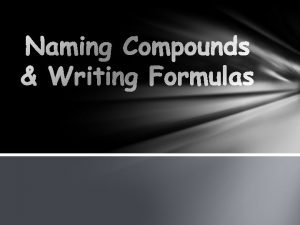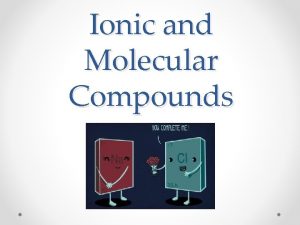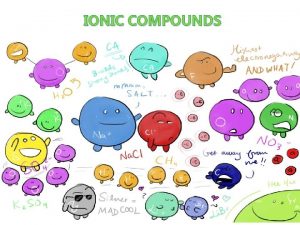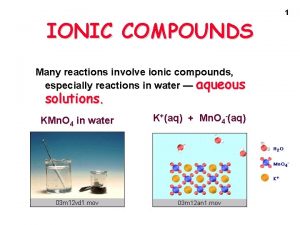HPLC Analysis of Ionic Compounds Nicholas H Snow




































- Slides: 36

HPLC Analysis of Ionic Compounds Nicholas H. Snow Seton Hall University

HPLC of Ionic Compounds • Ion Suppression • Ion Exchange Chromatography (IEX or IEC) • Ion Pair Chromatography (IPC)

Weak Acid Equilibrium

Le. Chatelier Principle DO NOT chromatograph at p. H = p. Ka !!

Ion Suppression • Weak acid - Use p. H 2 -3 – acetic or phosphoric acid • Weak base - Use p. H 8 – ammonium hydroxide, sodium carbonate • Ionization is suppressed • Neutral molecules chromatographed by reversed phase LC

Ionization Suppression Effect

Strong Acids and Salts 100% Ionized

IEC Mechanism

Anion Exchange

Ion Exchange

Ion Exchange

Ion Exchange Parameters • Increasing p. H – Increases ionization of acids - retained longer – Decreases ionization of bases - elute faster • Increasing buffer strength – More competition for exchange sites decreased retention • Increasing Temperature – Equilibrium favors mobile phase - retention decreases

Cation Exchange Resin

Anion Exchange Resin

Ion Exchange Resin Styrene-divinylbenzene

Ion Exchange Groups • Strong anion exchanger – -NR 3+ • Weak anion exchanger – -NR 2 H+ • Strong cation exchanger – -SO 3 - • Weak cation exchanger – -CO 2 -

p. H Effect

Ion Exchange Packings

Krebs Cycle Acids by Ion Exchange Chromatography

Ion Exchange Summary

Ion Chromatography • Originally meant IEX + suppressor device + conductivity detector • Inorganic cations and anions • Organic acids, amines carbohydrates

Ion Chromatography Schematic

Inorganic Anions by Ion Chromatography

Limitations of Ion Exchange • • • Less Efficient Columns Lot to lot column reproducibility poor Gradients require long equilibration Limited choice of packings Only ionic analytes

Ion Analysis

Ion Pair Chromatography • Adjust p. H to fully ionize analyte • Add ion pair former of opposite charge in mobile phase – acids (anions): tetraalkyl ammonium salt – bases (cations): alkyl sulfonic acids • Use standard reversed phase column

Reversed-phase

Ion Pair Mechanism

Ion Pair Mechanism

Ion Pair Mechanism

IPC Mechanism - Key

Optimizing IPC Separation

Effect of Organic Modifier

Effect of Ion Pair Reagent Concentration

Effect of Added Salt

Ion Pair Reagent Chain Length
 Snow snow snow teresa jennings
Snow snow snow teresa jennings Snow by teresa jennings
Snow by teresa jennings Ionic covalent and metallic venn diagram
Ionic covalent and metallic venn diagram Few snow or little snow
Few snow or little snow Writing formulas (criss-cross method examples)
Writing formulas (criss-cross method examples) Ternary ionic compounds
Ternary ionic compounds Monatomic ion examples
Monatomic ion examples Brittleness of ionic solids
Brittleness of ionic solids Molar solubility
Molar solubility Uses of ionic compounds
Uses of ionic compounds Steps to naming ionic compounds
Steps to naming ionic compounds How do you name an ionic compound
How do you name an ionic compound Prefixes for hydrates
Prefixes for hydrates Ternary ionic compounds
Ternary ionic compounds How to name ionic compounds
How to name ionic compounds Binary ionic compounds
Binary ionic compounds Unit 1 alchemy lesson 20 worksheet answers
Unit 1 alchemy lesson 20 worksheet answers What is the proper name for fe2se?
What is the proper name for fe2se? Ionic compound properties
Ionic compound properties Why do ionic bonds form
Why do ionic bonds form Dicarbon tetraoxide
Dicarbon tetraoxide Unit chemical bonding forming ionic compounds ws 2
Unit chemical bonding forming ionic compounds ws 2 Binary compounds chemistry
Binary compounds chemistry What happens when a molten ionic compound is electrolysed
What happens when a molten ionic compound is electrolysed Mono di tri tetra
Mono di tri tetra Ternary ionic compounds
Ternary ionic compounds Ionic compounds containing polyatomic ions
Ionic compounds containing polyatomic ions Concept 2 notes naming ionic compounds
Concept 2 notes naming ionic compounds Properties of ionic compounds
Properties of ionic compounds Lesson 17 technicolor atoms flame test worksheet answers
Lesson 17 technicolor atoms flame test worksheet answers Naming and writing formulas for monatomic ionic compounds
Naming and writing formulas for monatomic ionic compounds Ionic compound high melting point
Ionic compound high melting point Why do ionic compounds have high melting and boiling points
Why do ionic compounds have high melting and boiling points Common properties of ionic compounds
Common properties of ionic compounds Multivalent metals chart
Multivalent metals chart Flowchart for naming binary compounds
Flowchart for naming binary compounds What is binary ionic
What is binary ionic

